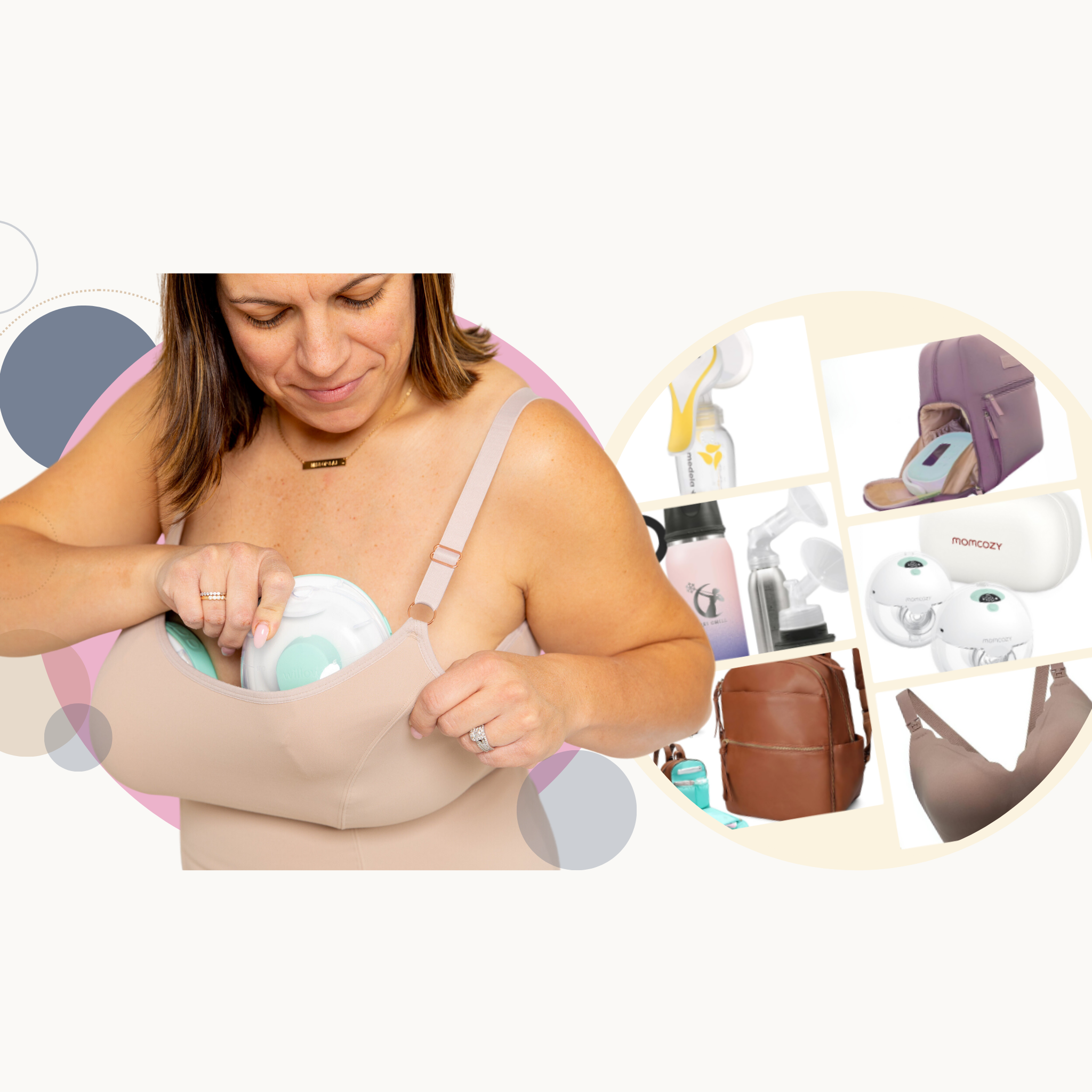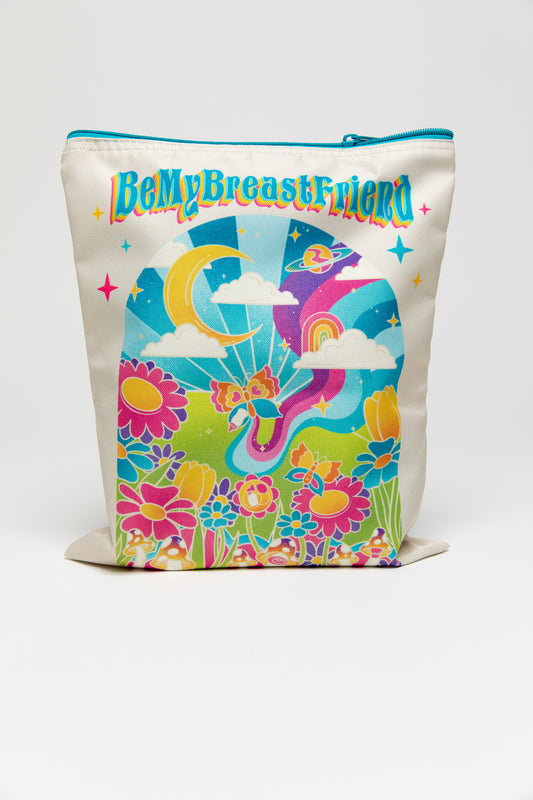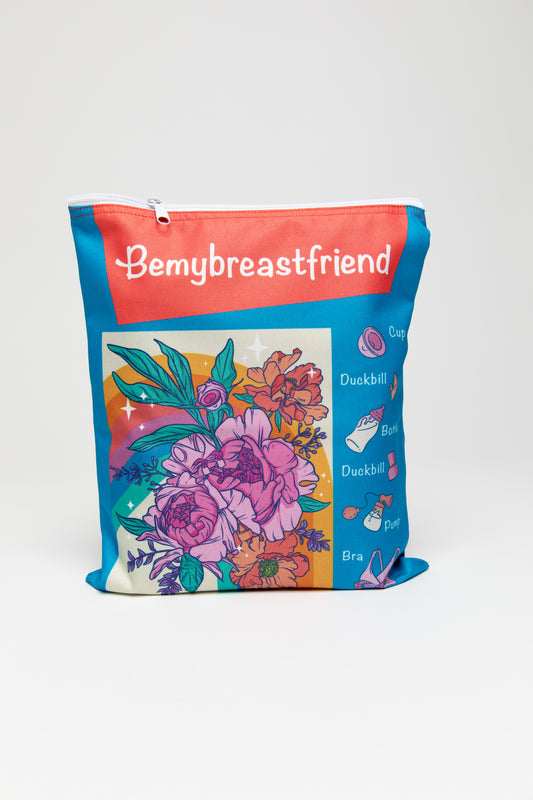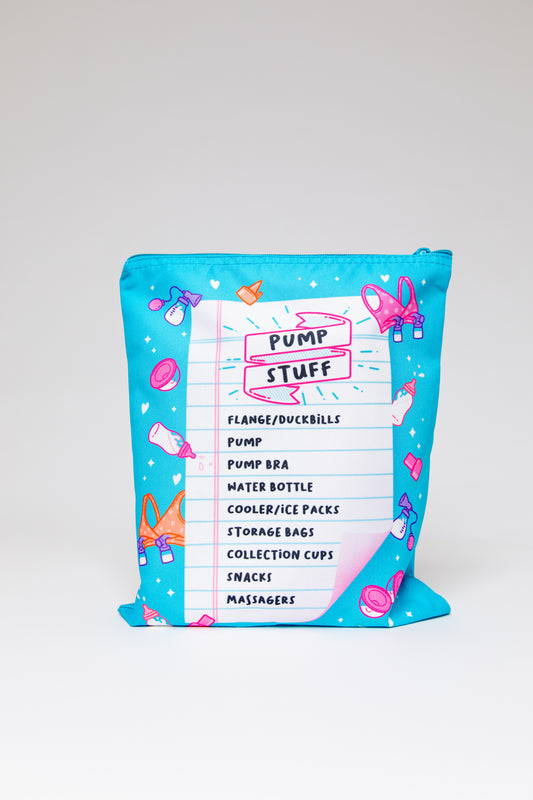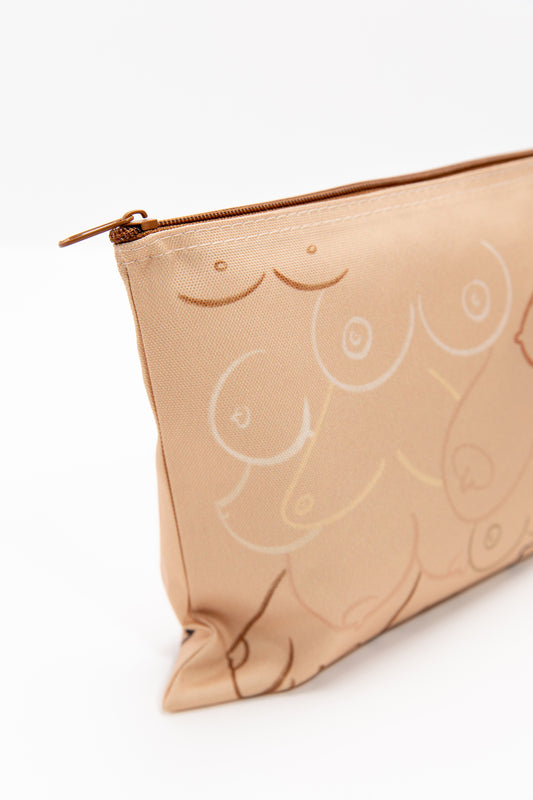
There’s a lot to unpack in this topic, so many variables and applications. As an exclusive breastfeeding mom you may find a pump that wouldn’t be considered primary for an exclusive pumping mom still be a good fit for you. Or visa versa, an exclusive pumping mom may need more tools in her breastfeeding tool chest than a mom who exclusively feeds at the breast. One thing we generally all have in common is the fact that many of us go back to work at some point in time, or vacation, or need to take an extended time away from baby here or there. These occasions, especially when going back to work, will still require us to rely on a more effective pump. At the end of the day moving milk effectively is a key essential piece to producing milk. So whether you’re feeding solely at the breast or relying on a breast pump to remove milk regularly. Being familiar and informed on our breast pump choices is still very important for all of us to understand and consider.
There are several categories to consider, no the term “hospital grade” is not one of them. Did you know this terminology holds little to no weight, being a hospital grade pump really only means that it can be used by several users. Hospital strength is also another term that holds little to no value. Pumps nowadays all teeter within several mmHg, milliliters of mercury, the standard unit of measuring vacuum pressure. So then you might be thinking, "okay, Kristen, where do I start now?" I have to agree this is a great question that already has me a little flustered just typing this intro. Let’s try to break this down a little further to help explain the do's and don’ts of navigating your breast pump purchase.
Primary breast pumps. What does this even mean and which pumps fall in this category. A primary pump will be your most effective breast pump. This pump will be your reliable, most used pump for adequate and frequent removal. What if you’re not an exclusive pumping mom? Your primary removal is your baby, however you will still want to invest in a pump based on how often you need to use it. If we are talking once a week, being perfectly honest, a manual hand pump may be all you need. If you’re a exclusive breastfeeding (EBF) mom and your going back to work, pumping 3-4 times out of the house you may want to choose a pump an exclusive pumper would be using.
So which pumps are these?
Considering basic insurance provided breast pumps, these options would usually include the: Spectra S1, Spectra S2, Spectra Synergy Gold, Motif Luna, Unimom Opera, Baby Buddha, Pumpables Genie Advanced, Limerick.
Pumps generally offered by insurance that I would recommend avoiding as primary: anything Medela, Willow, Elvie, Freemie, Motif Duo, Zomee Z2. Let me address the Medela listing because you might be thinking, “Medela? I thought that was the OG of breast pumps.” Yes, they’re definitely the OG, however their latest “and greatest” upgrades to the Pump in Style Advanced or PISA, which is now the Medela MaxFlow, is an insult and weapon against our milk supply. The Medela Freestyle Flex isn’t the worst pump ever but it’s no primary, you can find my review on this blog and Flex Chit-Chat here!
So let’s get back to what’s good. Some of these pumps offer different features and come in different sizes. The OG bowling ball Spectra S1 and S2 will likely be my first recommendation when taking an insurance based approach. The motor life of the Spectra pumps are second to none, gotta give it to them that credit- at a 1500 hour motor expectancy these pumps can run for a very long time. The Motif Luna would be my next consideration, this pump has been called the Little Sister to the Spectra S1 and S2. Both the Spectra and the Original Motif both had vibration. Motif did a little swaparoo on us about a year ago and removed the vibration for their Luna without making any indication to the pump itself. This being said, I don’t believe it should be called the Little Sister any longer, simply because it lacks the vibration that gave it this similar feature. Is the Motif Luna still a good pump? Yes, I agree that it is and this is why if I was up against the Spectra S1 or S2 OR the Motif Luna I would consider the fact one has vibration while the other does not. As a FTM, first time mom, you may be thinking, “what the hell does that mean.” I get it, I’m with you on that- allow me to try to explain. Pumps that had added vibration to their motors are a featured technology is to help stimulate milk let-down. This vibration can go either way; you may find it beneficial or it may cause your skin to crawl.

Then for those who liked vibration, did the prefer vibration provided by the pump or by an external source, such as a lactation massager ⬇️

Next if you already committed to a pump with built in vibration but found you didn't respond well to it, were the external massaging pads effective at distracting the vibration of the pump? This poll is a tough one since its 50/50, but if I could jump in and add my experience.. the Spectra S1 was my first pump and found it to be less than comfortable due to the vibration. I added in the external pads and found huge success because this added vibration trumped the pumps and allowed me to pump more comfortably.
"To order a pump with vibration or not to order a pump with vibration", this is such a difficult question to help answer, which will be best for you? The way I look at it, once you add the vibration to the pump you’re not removing it, if you have never used any other pump then this might not be such a factor to consider. Being honest, you may never know the difference. However if you’re like, "wow that sounds awful" or you have known nipple triggers then the Spectra S1 or S2 may not be your best choice. One thing I’ll say about vibration is you can’t remove it from the pump but you can add it to your sessions externally, in a way I have found super effective without the direct stimulation on your nipples. This said, the Motif Luna might be a better option because you can always add the vibration later.
What about those other options? If you’re looking for something that is smaller, no vibration and can pack a punch then the Baby Buddha is where you may want to start followed by the Pumpables Genie Advanced. These pumps are two of the smaller options on the market that can still be as effective as a bowling ball size primary breast pump. The general differences between pumps really come down to motor life, suction effectiveness and how user friendly they are. These smaller pumps don’t leave you with a ton of options when setting mode and cycle speed like you’d find with the Spectra, Motif or Limerick breast pumps. Is this a bad thing? No, I don’t think it is. I find having too many options can really over complicate things, I like having to only deal with suction strength without worrying about which cycle speed is best for me. If you find you need all these extra bells and whistles then I’d 110% jump right to the Spectra Synergy Gold (not portable version) or the Unimom Opera. Both of these options have twin motor pumps and a variation of cycle speeds and suction strengths that can be used in almost any combination!
More recently, currently April 2024, the Pumpables and Baby Buddha are finding their way into our insurance provided options, which I think is great. Even if you have to pay for either of these out of pocket they’re still affordable, both under $200. These pumps are easily hackable with any flange arrangement, any hack you do with one, will be the exact same as the other. They can equally be used as a primary or secondary, depending on your flange arrangement. The main difference between these two top choices will be the suction sequence and strength. The Pumpables Genie Advanced has a more steady suction pattern which most find very comfortable and effective. The Baby Buddah has multiple modes to choose from, each having their own suction pattern. The unique asset to the Baby Buddah pump is the "long pull", this mode has a reputation of drawing more milk at a faster speed. This mode is loved among many but can also be considered too rough for others. I have personally been on both sides of this fence. I loved the Baby Buddha for over 30 months (collectively), then when my third pumping journey came I had a difficult time picking it back up. I am currently 27 weeks pregnant and will give each a fair run, come this June '24!
Pumpables Genie Advanced, use code BREASTFRIEND for 10% off
Baby Buddha, use code BEMYBREASTFRIEND for 10% off
or if you're an Amazon shopper- the Baby Buddha is sold there too, use code BESTIE10OFF for 10% off at Amazon checkout
Now let’s shift gears to those secondary options, pumps that don’t have the best reputation at always successful removing milk. These pumps are also offered with many insurance providers but there’s not asterisk warning you they’re not the best choice as primary. These pumps include the Medela Freestyle Flex, Zomee Z2, Spectra S9, Spectra Synergy Gold Portable, Elvie Stride. Just because they’re small or carry a reputable name brand doesn’t make them desirable pumps. How would you know? I guess you wouldn’t that’s why I’m glad you found this blog to reference.
Let’s jump into those in your bra, both expensive and inexpensive mobile pumps that have tons of advertising behind them pushing their marketing right into your algorithm! I'm talking about the Willow 3.0, Willow Go, Elvie and other in your bra mobile pumps. Those first three are the front runners, they have been around the longest and are usually assumed to be the top choices simply based on that fact alone. There are other pumps that seat right in the bra minus any tubing such as the Momcozy, Zomee Fit, Motif Aura, not all of these others are insurance covered but if they are consider they’re on this list too. These options, which are far less expensive have the ability and reputation of being more reliable than the big money pumps first listed (with the exception of the Motif Aura).
Considering all of these mobile pumps, first and foremost, they should never be considered a primary option for anyone needing to remove milk from their breasts by pump more than 3-4 times a day. These pumps, generally speaking, are ideal for on the go, away from baby, need to remove milk while staying busy, kind of pumps. These pumps do not provide the same adequate removal that primary motors attracted by tube to traditional flanges provide. Breaking this category down even future, some of these pumps are more difficult to use than others. For example; the Willow 3.0 has a spectrum of colors to consider while troubleshooting this pump, which never seems to stop erroring out. The Willow Go however has proven itself to be an easy to use mobile, highly more favored over the 3.0. The Elvie also has a learning curve while the Motif Aura was likely put through production overnight without any consideration or consumer testing (as Jean Ralphio would say, “she’s the worrrrssttt”).
Mobile pumps are just that, meant for mobility. They can be a great asset to an EBFing mom who doesn’t need to rely on a breast pump. This said mom may only need to move milk by pump a few times a week or possibly parallel pumping while baby feeds on one breast. This would be my exception from discouraging you from investing in a mobile as a primary option. Just because a pump is expensive or seem to have great marketing behind it doesn’t make it a top choice *cough cough* Elvie and Willow 3.0. Believe it or not, those less expensive mobiles such as the Momcozy S9 pro, S12 Pro or M5 can be a satisfactory fit for you. The Zomee Fit is middle of the road in price but more effective and easier to use than any Willow or Elvie pump. Zomee recently (March 2024) made an upgrade to their mobile pump which includes volume sensor options and an inverted/flat nipple corrector. You have my word, the Fit is another fair choice if looking for a mobile of this style.
Not a pump but a common add-on to many of our pumping routines. Mobile cups. Cups are an inexpensive way to modify our pumping session allowing us to pump more discretely and most times, on the go. I’m a huge fan of cups but I’ll also be the first to warn against them as primary.
Kristen, can I use mobile pumps paired with my primary pump as a regular source of milk removal?
No, I hate to burst your bubble, but you can’t or maybe I should be saying, "you really shouldn't". When you add a set of mobile cups to even your most effective primary pump you’ve just brought that primary pump down to secondary level. More times than not you’ll find your breasts aren’t emptying as well, even with the same effective pump, while using with mobile cups. Why? Mobile cups don’t seat on the breast the same as traditional flanges. Cups also don’t allow for hands on massaging because they take up so much more surface area on our breasts, this makes it difficult to remove milk or encourage a let down if hands on pumping is a key component for you.

Another topic which I will have to dedicate to another blog will be silicone vs plastic flanges. This is an entirely different topic to unfold. Just like there are different pumps, there’s also different flange options for different needs. Stay tuned.
Oh geez, it doesn’t end. Let’s also dive into passive collection options such as silicone pumps and non-motorized cups in another blog too! Until then listen to THIS episode of Tired Moms Club Episode 34- all about passive milk collection options.
At the end of the day considering your primary need for a breast pump is where you will start. Then you can begin to narrow down your options based on provided lists. If you’re looking for a specific review always head to bemybreastfriend.com, search the key word in the site search engine and see which blogs populate! If you’re looking for something and can’t find it, please let me know below!
Did you know Julie Matheney from LA Lactation and I went live discussing our favorite versus least favorite pumps?
Check out the Instagram Live HERE!



